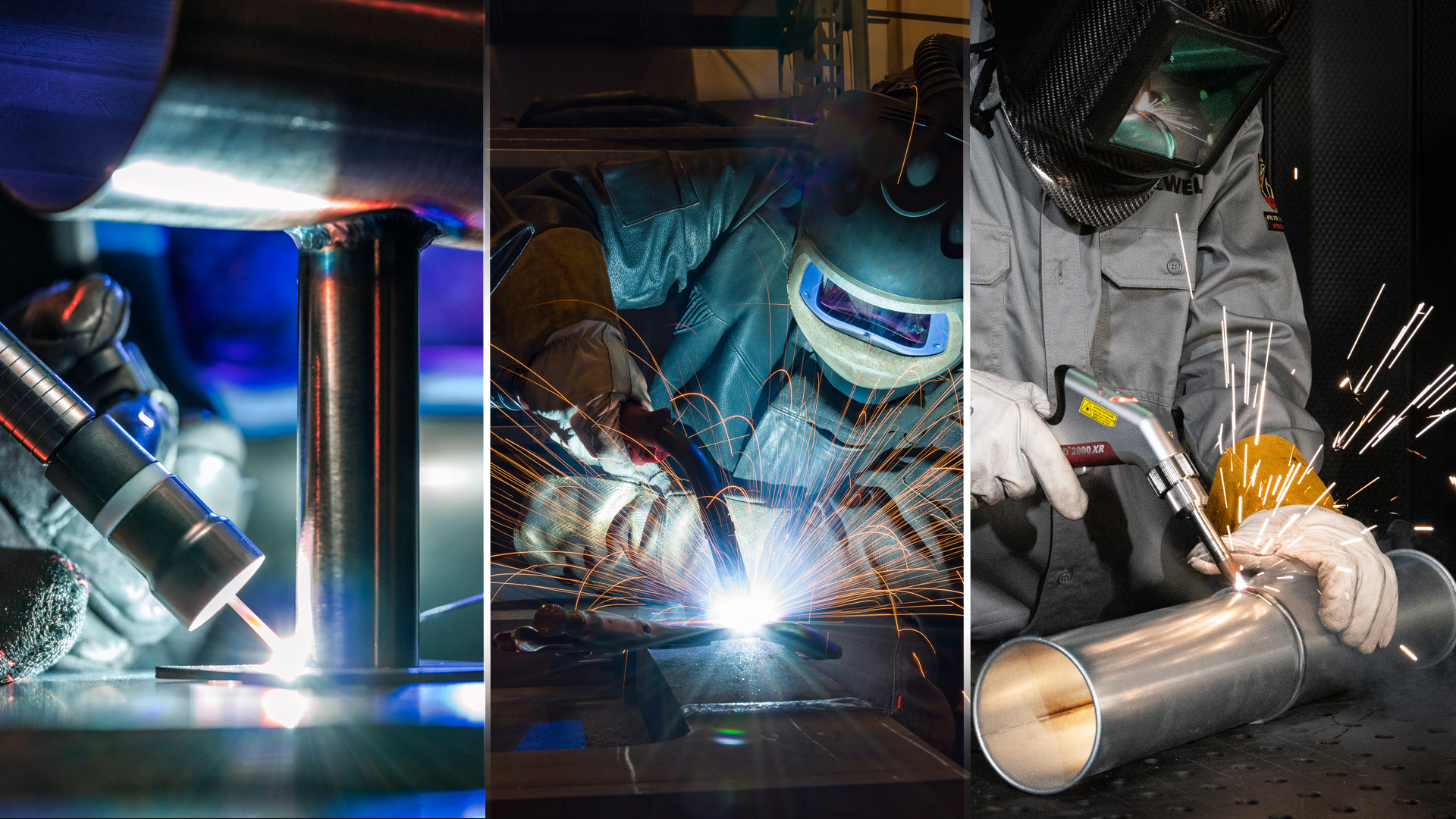MIG & TIG vs. Laser Welding: Advantages & Differences

All of us on the LightWELD team are excited by laser welding and its place in the future of the craft. And so are our customers, who love to tell us all about the laser welding projects they’ve worked on.
But as handheld laser welders rise in popularity, and as the technology continues to improve, there has been some uncertainty. Is laser welding a replacement for arc welding? Are tools like LightWELD intended to disrupt the market?
The answer to both questions is no. Laser welding is undeniably powerful, but it can’t do everything. Among some of the most common welding methods – MIG, TIG, and laser – each has its share of advantages and disadvantages.
Let’s break them down.
MIG, TIG & Laser Welding: Overview & Differences
You can think of each type of welding like a painter thinks of a set of paintbrushes. Each brush is ideal for a different task although they can sometimes be used in place of one another in a pinch.
Dubious analogies aside, there is an important difference between arc welding and laser welding and it’s all in the physics.
Arc welding uses electricity (electrons) while laser welding uses light (photons). While both ultimately mean energy, and thus heat, is transmitted into the target material, the nature of photons allows them to focus closer together to produce significantly higher energy densities. In simple terms, that means more energy is concentrated in a smaller area.
Beyond energy density, light also interacts with target materials differently than electricity does. Although arc welding processes give off intense light, the light itself is responsible for virtually none of the metal-melting heat. The specifics, however, come down to rather complicated subatomic interactions that aren’t necessary for most welders to understand.
What is important to understand is that the fundamental differences and similarities between arc and laser welding impact when and how you should use each one.
MIG Welding vs. Laser Welding

Advantages of MIG Welding
MIG welding is something of a jack of all trades. An extremely versatile method used by hobbyists and large operations alike, MIG welding is fairly fast and capable of creating high-quality welds with moderate post-weld clean up.
MIG can be used for most common metals, including mild steels, stainless steels, aluminum, nickel, and copper, with thicknesses ranging from very thin to somewhat thick. MIG is also relatively easy to learn despite requiring significant time to master.
Compared to laser, MIG is much better suited for parts with wider tolerances or poor fit up. Alongside the lower initial price point of most MIG welding setups, MIG is an appealing option for individuals and smaller welding operations.
Advantages of Laser Welding
Laser welding, while not quite as versatile as MIG welding, typically outperforms it head-to-head. In common metals from very thin to roughly 5/16” thick, laser welding is significantly faster and creates strong, extremely high-quality welds. The final seam almost never needs to be grinded and often requires minimal or no clean up.
Even compared to MIG, laser welding is uniquely easy to learn. Novice and experienced welders alike are typically able to lay down beautiful welds within a few hours and often master laser welding within weeks or months.
Laser welding also imposes few limits on welder positioning. Due to the nature of MIG weld pools, it is not well-suited for vertical or overhead welding. Laser welding, by comparison, creates a less fluid pool and can be used in nearly any position.
TIG Welding vs. Laser Welding

Advantages of TIG Welding
Commonly used when MIG welding won’t do the trick, TIG welding is often used by more advanced welders and welding operations. TIG welding is well-suited for a variety of thinner materials including mild steels, stainless steels, aluminum, titanium, and copper. However, TIG can also be used in medium thickness metals up to roughly 5/8” or so, although that is not its strong suit.
TIG offers welders a lot of control over the weld pool and heat input, and can be used to make precise, high-quality welds with an excellent finish. With a skilled welder, TIG offers versatility and quality for an affordable initial cost.
Advantages of Laser Welding
Laser welding is well-suited for most of the same applications as TIG. In those applications, laser welding offers a number of advantages.
The most distinct advantage is in welding speed. With TIG’s precision and control comes long welding times. As one of the fastest welding methods, laser welding is typically around four times faster than TIG welding, although it is often even faster.
TIG is also considered one of the most difficult welding methods to learn. By comparison, laser welding is considered one of the easiest. For veteran welders this may not seem like a big deal, but it can have a big impact on how long it takes new welders to start being productive after they’re hired.
While welders can control the heat input of TIG, it tends to produce a large, unforgiving heat-affected zone (HAZ) that can lead to distortion and other quality problems. Laser beams are exceptionally more energy dense than TIG arcs and laser welding suffers from a much lower HAZ as a result.
Although both TIG and laser welding are known for high weld quality, laser welding tends to have the edge in most applications. The quality and appearance of laser welding is sometimes considered too good to be true, which has prompted some study on the subject.
A Note on Safety
The safety of laser welding is a reasonable concern for most welders and welding operations. While laser welding requires many of the same precautions as MIG and TIG, there are some notable differences like required eye protection, laser safe enclosures, and laser safety officers. We go over the specifics in Everything You Need to Know About Laser Welding Safety.
Is Laser Welding Right for You?
Laser welding is finding its way into the hands of more and more welders each day. And for good reason: laser welding is fast, easy to learn, and produces excellent welds.
But that doesn’t mean it’s the right fit for every welder or operation. Here’s a helpful overview.
When to Consider Laser Welding
Laser welding is an excellent choice for welders and shops that regularly weld relatively thin metals under 5/16” or so. Laser welding is particularly likely to benefit operations that need to make a high volume of welds or that can otherwise benefit from huge increases in productivity.
Laser welding often allows fabricators to take on more work, whether due to expanded capabilities or higher welding speeds. Look no farther than the many aerospace and automotive companies that have increasingly favored laser welded assemblies in the past few years.
The relatively low barrier to entry is also worth considering for many. Welding shops frequently represent a spectrum of welding experience. Newer welders can take advantage of laser welding to bring more value sooner. Veteran welders can take comfort knowing that it’s relatively easy to add laser welding to their repertoire but that time and practice is still required to achieve mastery.
When NOT to Consider Laser Welding
If you mostly weld thicker materials, then laser welding may not be as beneficial for you. Laser welding produces strong welds with a high depth to width ratio but is not generally suited for metals around ½” thick or more.
You should also very carefully consider your welding workspace and if you are capable of ensuring and enforcing laser safety. Laser welding must be performed in a laser safe enclosure, ideally with safety interlocks, and laser safety practices must be enforced by a designated laser safety officer.
Speaking of safety, if you mostly weld in the field then laser welding may be less appealing. Although many welders laser weld outdoors and in the field, you must be prepared to take necessary precautions.
Finally, laser welding is not always a good match for hobbyists or shops with limited budgets. Although the longer-term ROI of laser welding is usually very high, the initial cost of a high-quality handheld laser welder from a reputable brand may be prohibitive. Learn how the cost of laser welding equipment can be offset with tax incentives here.

